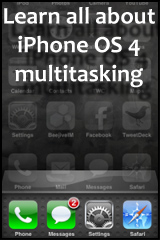The answer to why some don’t see the iPhone 4 bars drop in their left hand
by Justin Horn on Jun 30th, 2010 @ 10:39 am Image from Anandtech
Image from Anandtech
The short answer…it does, you just don’t see it in “the bars”.
I first thought this could be the answer way back on the June 24th during my bumper testing:
I then tested in another room with less electronics. In this room I started with a strong signal of 5 bars. This time around, with or without the bumper, the signal held pretty much at 5 bars. This may explain why some people don’t seem to notice this issue. If you have really great AT&T service where you live, the in hand signal drop may not be as noticeable.
After reading John Gruber’s post backing up my idea, I did a more specific follow up post on the issue:
I think the problem is “the bars”. They serve their purpose for the most part, but when trying to do a test involving signal strength we need more detail. I would argue that 5 bars in one area is not necessarily equal to 5 bars in another. Start with a “weak 5 bars” and you can see the signal loss represented by the bars dropping. Start with a “strong 5 bars” and the signal may be getting weaker, but never below the 5 bar threshold. In this case it appears to the user that they still have the same signal strength and it goes unnoticed.
Turns out the “not all 5 bars are created equal” was dead on. It was hard to prove this before because the old field test app that showed these numbers was removed from iOS 4. That didn’t stop Anandtech though, with a neat hack job they were able to get the numeric signal number back on iOS 4 instead of the bars:
However, you can see just how little dynamic range iOS 4 has for reporting signal; over 40% of the range of possible signal levels (from -99 dB to -51 dB) is reported as 5 bars.
They go on to test the drop in signal by how it’s held:
Tight grip in hand: 24.6 dB
Holding naturally in hand: 19.8 dB
Holding naturally with case: 7.2 dB
Open palm: 9.2 dB
Now let’s revisit my bars and bumper test with the dB numbers provided by Anandtech:
Strong 5 bars (Naturally held)
You start with the strong 5 bars at -60 dB (-51 dB would be strongest 5 bars), then you hold it in your left hand, lowering the signal to -79.8 dB (-51 dB – 19.8 dB). Even though you have a significant drop in signal, it’s still above the -99 dB threshold for 5 bars, so it goes unnoticed in the bars. If you did a speed test before and after, you would be able to see the difference…try it.
Weak 5 bars (Naturally held)
You start with the weak 5 bars at -90 dB (-99 dB would be weakest 5 bars), then you hold it in your left hand, lowering the signal to -109.8 dB (-90 dB – 19.8 dB). This now takes you past the 1 bar threshold of -107 dB. With 1 bar you can still make calls, but have a better chance of a drop. The bigger issue, at least for me, is the 3G data speeds drop dramatically.
Bumper (Naturally held with case)
I know I was starting with a signal that was on the lower end of 5 bars because every once in a while it would drop down to 4 bars. For this example let’s assume it was -95 dB. Holding naturally with the bumper it would drop down to -102.2 dB (-95 dB – 7.2 dB) putting it in the 3 bar range, exactly what I got during my test.
Another way to think about it in terms of bars would be to add 5 more bars on top of the 5 that already exist. Not as an average, but just adding more detail to the high end. The user that claim they don’t have an issue are really starting out with 9-10 bars in this 10 bar and dropping to 5-6, but those that start with 5 are dropping to 1.
So those of you that were counting yourself lucky are just starting off better, but when you aren’t holding your phone you still have a stronger signal.
Follow me on Twitter @justin_horn
View 8 Comments
Antenna Issue, Featured post, iPhone 4
Recent Post
- More details on the iPad mini new multitouch feature
- iPad Mini predictions
- Zune still the butt of jokes, this time on the Simpsons
- AT&T LTE No Service: Too many LTE iPhone 5 users?
- iPhone 5 cellular usage while on WIFI bug affects AT&T users as well
- Tim Cook responds to iOS 6 Map app issues in public letter
- iPhone 5 screen vs iPhone 4: Really close up
- iPhone 5 line at 5th Ave Apple Store (Updated 11PM)
Featured Post
Comments
Sorry, the comment form is closed at this time.



[...] [Anandtech via When Will Apple?] [...]
[...] the bars more evenly across the range of signal strength. Basically fixing my statement that not all 5 bars are not created equal, now the weak 5 bars will just show as [...]
[...] the bars more evenly across the range of signal strength. Basically fixing my statement that not all 5 bars are not created equal, now the weak 5 bars will just show as [...]
[...] [Anandtech via When Will Apple?] [...]
The algorithm is the problem in the iPhone what causes the cut outs with the people who have low signal in their area.
Because the algorithm is the key what rules the signal boost when the signal is low, the boost is never enough that the signal could be maintained good when touching the antenna.
I have Nokia 6121c and I have 7 bars range. I have three (3) cell tovers about 1km away from me. All what is between me and them, are the walls of the house (wooden house) and if I go to yard, I get straight line to them. When I take phone to hand, it drops ONE bar always. The reception is great when it is good day but when there is moisture in the air (>60%) the signal quality drops worse. But when I take this phone and I take it same way as “grip of death”. I get 4-5 bars drop. Just with one hand. When I place the phone to table or I keep it just with two fingers from keypad, I get first 5 and then 7 bars.
The 6121c is Nokias phone what has internal antenna and plastic case. Typical Nokia phone. It just does not drop the signal because the algorithm.
People should know that the algorithm is not just responsible to show the graphical data about the signal strenght. But it is responsible as well to boost the signal reception and sending. The cellphone acts that way when the signal is low, the phone use more wats (max 2W) to maintain signal.
What higer the signal, then lower the power consuption. And we all know that 2W is a lot of power to consume when we talk about cellphones batteries.
If the algorithm is wrong, that it show full bars in 23% reception. It means that when you take the phone in hand, you get the “one bar drop” and the algorithm boost the signal too little to actually correct the touching. The bumbers can not fix all that because the boost is just too small. If the algorithm would be correct, the signal would not drop at all because the phone would use 1-2W and not 0.1-0.5W power.
[...] [Anandtech via When Will Apple?] [...]
Also, you can check the numeric signal number without an app, just by calling this:
*3001#12345#*
[...] via When Will Apple?] Tags: Hold Different, Iphone 4, Iphone 4 Bugs var addedComment = function(response) [...]